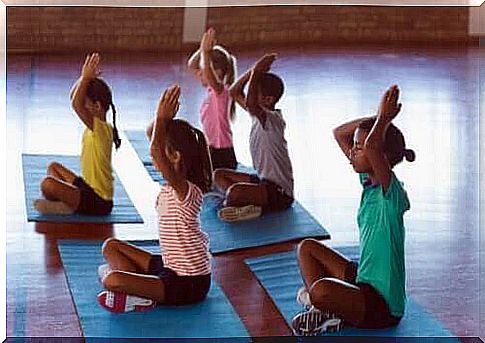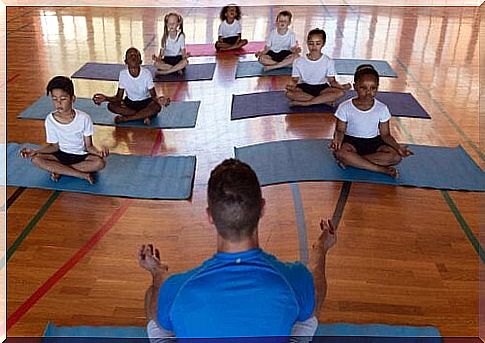Yoga In The Classroom: Essential Elements And Benefits

Practicing yoga has many scientifically proven benefits for the physical and mental health of both children and adults. What benefits can we gain from practicing yoga in the classroom?
To begin with, it is important to note that several research studies have found that practicing yoga in the classroom has many benefits for children. First of all, the benefit that seems perhaps most obvious has to do with well-being.
Furthermore, the practice of yoga in school can also help children improve their grades. On the other hand, educators also benefit from this practice.
Benefits of practicing yoga in the classroom
Yoga in school has proven to benefit both children and young people. Yoga in the classroom, for example, not only promotes processes related to self-esteem and self-confidence, but it also helps regulate stress and improve concentration. It has a very positive effect on the learning process.
Specifically, the primary benefits for children of practicing yoga in the classroom are the following:
- Reduces stress and anxiety. The desire to excel and show their worth along with the pressure from their surroundings is very stressful for children. Yoga helps to stop thoughts from raging and enables children to live in the present to the fullest. Therefore, it helps reduce stress and anxiety, as well as regain peace and quiet.
- Improves memory and attention span. Yoga helps to improve memory function in both children and adults. It also helps improve children’s attention span and focus.
- Improves academic performance. By being more calm and focused – with stress under control – children have the opportunity to dedicate more resources to their studies. This will thus significantly improve their academic performance.
- Leads to a more active lifestyle. Children spend a lot of time sitting down in the classroom. Therefore, yoga helps them break the cycle with an inactive lifestyle and helps them acquire healthy habits.
- Improves posture. One of the problems with sitting on non-ergonomic chairs for a long time is that it is easy to have a bad posture. Yoga helps children acquire a healthy posture.
- Teaches breathing techniques. Breathing is essential for life. Breathing techniques in themselves help children control their breathing. It also helps them relax and oxygenate their brain.

More benefits of practicing yoga in the classroom
- Promotes full attention. Mindfulness means knowing how to be present in the present. It helps children focus on what is happening here and now, and appreciate the qualities and opportunities that are available at any given time. As a result, it reduces stress and anxiety. Learning these techniques gives educators the opportunity to help children who are having difficulty or reassure the class if distractions occur.
- Improves self-control. Many problems can arise in the classroom due to children’s problems with self-control. Learning yoga techniques helps educators maintain order, and it helps children improve their attitude and relationships. As children progress in their yoga practice, they will actually have more control over themselves.
- Improves mastery skills. Children face several stressful situations, and the practice of yoga teaches them how to master and deal with stress properly.
- Improves the immune system. Regular practice of yoga improves immunity, helping children to be better prepared for various diseases.
- Improves sleep quality. Children need a lot of sleep and good sleep. In this regard, yoga is helpful because it promotes a calmer life and the children are thus more relaxed at bedtime. It not only helps them to get to bed earlier, but also to sleep better.
Teachers also benefit from yoga
Yoga in the classroom also has many benefits for teachers. On the one hand, teachers can do their job better if students are more calm and attentive. It will help them feel more confident and dedicated in their work.
At the same time , teachers who do yoga with their students develop a closer bond with them. This facilitates the creation of a climate of greater trust. Furthermore, educators can achieve the same physical and emotional benefits as children.
Now that you know the many benefits of yoga in the classroom, what are you waiting for to give it a try with your students?









